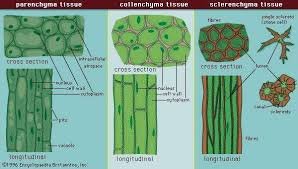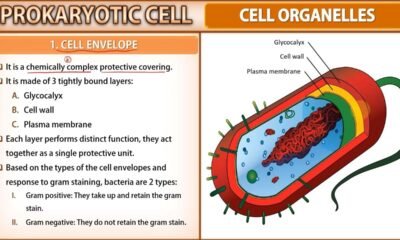Blog
3 Types of Simple Permanent Tissue | Free Biology Notes

In this article, we will discuss into the fascinating world of plant biology by exploring three types of simple permanent tissue: Parenchyma, Collenchyma, and Sclerenchyma Tissue.
Parenchyma Tissue Characteristics
- Parenchyma is living and arranged loosely with intercellular spaces
- Cells are compactly packed, or they have intercellular spaces between them
- Parenchyma consists of oval, round, polygonal, elongated or irregular cells
- Parenchyma cells are thin-walled. The cell wall is made up of pectocellulose
- It is the most abundant tissue, found in:- cortex, pith and leaf mesophyll
Types of Parenchyma Tissues
Chlorenchyma
The mesophyll part of the leaves contains chlorenchyma. Chloroplasts can be found in these parenchymal cells. Furthermore, these cells can be discovered in the immature plant cortex of the plant’s stem. Multiple intercellular gaps are present in these cells, which are loosely packed. The stem and aerial roots of plants obtain their green colour from chloroplasts, not chlorenchyma cells. The job of these parenchymal cells is to manufacture food through the process of photosynthesis.
Aerenchyma
The parenchymal tissues are most commonly seen in aquatic plants, where they help the plants maintain their buoyancy. These parenchymal cells are loosely packed, with wide intercellular gaps that allow for the presence of air holes or air pockets, providing the plant with the necessary buoyancy. The plant can also use the gases (oxygen or carbon dioxide) trapped in the aerenchyma.
Prosenchyma
These types of parenchymal cells are usually found in the vascular tissues of plants. These cells characteristically possess pointed ends and are elongated, narrow cells.
Medullary parenchyma
As its name suggests, the medullary parenchyma consists of parenchymal cells found in the medullary ray of the primary vascular tissue of the stem. These parenchymatous cells are thin-walled, radially elongated cells that carry out the radial distribution of water and nutrients to the plants. These cells also function as a storage of starch grains.
Armed parenchyma
These are the star-shaped parenchymatous cells found in the mesophyll part of the gymnosperms (e.g. in pine tree leaves).
Xylem Parenchyma
The cellulose-based cell walls of xylem parenchyma cells are alive and thin-walled. They store carbohydrates, fat, and other compounds such as tannins in the form of food. The ray parenchymatous cells transport water in a radial direction.
Phloem Parenchyma
Elongated, tapering cylindrical cells with dense cytoplasm and nucleus together make up phloem parenchyma tissue. Cell walls are made of cellulose and have pits through which plasmodesmata connects between cells can be made. The phloem parenchyma stores food material and other substances like resins, latex, and mucilage. Phloem parenchyma is absent in most of the monocotyledons.
Functions of parenchyma tissues
- Parenchymal cells are part of the ground tissues of the plants. Ground tissues are the tissues apart from dermal and vascular tissues.
- Storage of food & nutrients like starch, hormones, proteins, etc. is the primary function of parenchyma in plants.
- One of the key roles of Parenchyma Tissue is in the manufacturing of food through photosynthesis. This practical implication helps students grasp the importance of this tissue type in the life cycle of plants.
- In leaves, guard cells for gaseous exchange
- Parenchymal cells act as a store for water in xerophytes
- Helps in providing structure to the plant by giving a mechanical rigidity to it
- Parenchymal cells play a crucial role in the growth and development of the plant, a function that we can all appreciate in the beauty and diversity of the plant kingdom.
- Metabolic activities are carried out in parenchyma
- Wound regeneration, healing, and repair
- Parenchymal cells also specialize in providing buoyancy to certain aquatic plants
- Storage of the ergastic substances like resins etc
- Parenchymal cells of the xylem and phloem help in the transportation of water and nutrients throughout the plant
Collenchyma Tissue Characteristics
- Collenchyma are living mechanical tissue
- The shape of collenchyma cell can be variable. It may be oval, spherical, round or polygonal
- Cell wall contains cellulose, hemicelluloses and pectic materials
- Cellulose, hemicellulose and pectin are deposited at the corners of cell
- Found in under the epidermis of young stems, leaf veins, leaf margins and petiole
- Collenchyma is absent in mature plant parts, roots and monocots
- Intercellular spaces are absent and cells are compactly arranged
Types of collenchyma tissue
Depending upon the pattern of wall thickening and cell arrangement and their location, the collenchyma tissues are classified into following types.
Angular collenchyma
- Most common type of collenchyma tissue
- Intercellular spaces absent
- Cell wall deposition occur at corners of cells
- E.g. Solanum
Lacunar collenchyma
- Cells posses large intercellular spaces
- Cell wall deposition occur on walls which are in front of intercellular spaces
- E.g. Cucurbita stems and areal roots of monsteria
Lamellar collenchyma
- Cells are closely arranged horizontal line
- Cell wall deposition occur on parallel cell surface (tangential walls)
- E.g. Sunflower stem
Function of collenchyma
- Collenchyma gives mechanical support to the young dicot plants
- They are more flexible tissue
- Collenchyma with chloroplasts can perform photosynthesis
- Collenchyma together with parenchyma and sclerenchyma provides extra strength to the plants at different stages of development
- Leaves are not teared in high velocity of wind because they have collenchyma tissue
Sclerenchyma Tissue Characteristics
- Sclerenchyma are dead mechanical tissues occurring in mature organs of plant body
- Cells of sclerenchyma are long, narrow, thick walled, lignified without protoplasts
- Pits are also found. It may be simple pits or bordered pits
- Found in cortex, pericycle, xylem and phloem region
- Main function is provides mechanical support to plant organs
- Based on size and shape sclerenchyma cells are of two types:- Sclerenchyma fibres and Sclereids
Sclerenchyma fibres
- Fibres are longest cell in higher plants. 13mm in angiosperm and 28mm in
gymnosperms i.e. Boehmeria nivea (55cm) - Walls of fibres are lignified, hard, uniformly thickened with pointed ends
- They have simple pits as well as bordered pits
- Fibres are associated with vascular bundles
- Their cell lumen is very narrow
- They are present in almost all plant parts
- Main function is provide mechanical support in plants
Sclerenchyma:- sclereids
- Sclereids are short, extremely thick walled and their ends are not pointed
- Sclereids are various shaped and very small lumen
- They generally found in hard parts of the plant
- The sclereids provide mechanical support and hardness
Functions of sclerenchyma
- It provides mechanical strength to the plant
- It is involved in providing protection and strength to the plant body
- It makes the plant body rigid, flexible, and elastic

 Blog5 months ago
Blog5 months ago[PPT] Human Reproduction Class 12 Notes
- Blog5 months ago
PG TRB Botany Study Material PDF Free Download

 Blog5 months ago
Blog5 months ago[PPT] The living world Class 11 Notes

 Blog5 months ago
Blog5 months agoCell The Unit of Life Complete Notes | Class 11 & NEET Free Notes
- Blog5 months ago
Contribution of Indian Phycologists (4 Famous Algologist)

 Entertainment4 months ago
Entertainment4 months agoIbomma Bappam: Redefines Telugu Streaming Trend
- Blog5 months ago
Class 12 Biology Notes Chapter wise PPT
- Blog5 months ago
Class 10 Biology Notes Chapter wise PPT










